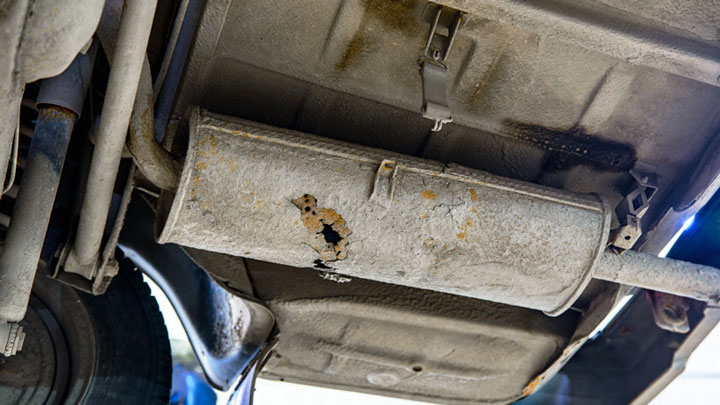How to fix hole in car exhaust pipe? To fix a hole in your vehicle’s exhaust pipe, locate the hole, prepare the area around the hole, apply epoxy putty, and let it dry. You can also use an exhaust patch kit if the hole is too large. If your exhaust system has a hole, it can reduce fuel efficiency and increase noise pollution.
The exhaust system is a crucial component of your vehicle that requires regular inspection and repair. It reduces harmful emissions and noise from your car’s engine. However, your exhaust pipe may develop holes over time, leading to toxic fumes entering your car’s cabin.
This article will provide a detailed guide on repairing a hole in your vehicle’s exhaust pipe, signs of a damaged exhaust pipe, and how to maintain your exhaust pipe to avoid damage.
A Table Of Causes And Signs Of A Hole In Your Exhaust Pipe
Here’s a table outlining the causes and signs of a hole in your exhaust pipe. By identifying these causes and symptoms, you can take action to fix the issue and keep your vehicle running smoothly.
| Causes | Signs |
| Rust or corrosion | Loud rumbling noise while driving |
| Damage from debris or road hazards | Hissing or popping sounds coming from the exhaust |
| Exposure to extreme temperatures | Reduced fuel efficiency |
| Wear and tear from age or mileage | Unpleasant smells, such as burning oil or fuel, inside the car |
| Faulty installation or poor maintenance | Visible holes or cracks in the exhaust pipe or muffler |
It’s essential to address any signs of a hole in your exhaust pipe as soon as possible to prevent further damage and ensure your vehicle is safe to drive.
Tools Required To Fix A Hole In Your Exhaust Pipe
You’ll need the following tools and materials:
- Protective wear such as gloves, a mask, and goggles
- Car lift or jack stands
- Socket set
- Sandpaper or wire brush
- Heat-resistant epoxy putty
- Exhaust tape or an exhaust repair kit
- Hose clamps

Best Way to Fix Hole in Exhaust Pipe: Step-By-Step Guide
You can use 2 methods to fix a hole in the exhaust of your vehicle. One is Using Epoxy, and another is Using An Exhaust Repair Kit. Let’s see how to do so.
Method 1: Using Epoxy
Follow the following steps to fix your vehicle’s exhaust hole by using epoxy.
Step 1: Preparation
To avoid fume buildup, park your vehicle in a well-ventilated area. Remember to wear protective equipment such as gloves, safety glasses, and a mask.
Next, raise the vehicle using a car lift or jack stands to gain access to the exhaust pipe. It is critical to choose a suitable surface that can withstand the weight of the car. Do not use a jack on grass, dirt, or gravel since it increases the chance of the jack toppling over.
Step 2: Locate The Hole
Turn on your vehicle and listen for a hissing sound, a sign of a hole. You can also visually inspect the exhaust pipe for signs of damage, such as rust or a visible hole. Once you’ve identified the hole’s location, mark it with a piece of chalk or a marker to make it easier to find later.
Step 3: Prepare The Area
Before fixing the hole, ensure the area around the hole is clean and free of dirt or debris. This will help the repair materials adhere better to the pipe. Use a wire brush or sandpaper to clean the area thoroughly.
After brushing or sanding the pipe surrounding the leak, clean it with acetone to assist the exhaust epoxy in attaching to the metal.
Step 4: Seal The Hole
There are several ways to seal a hole in the exhaust pipe, but one of the most effective methods is to use a high-temperature or metal-filled epoxy. These epoxies are designed to withstand high temperatures and provide long-lasting, durable repair.
Use a putty knife or similar tool to apply the epoxy to the hole, covering the area completely.
Smooth out any bumps or rough spots and let the epoxy dry. This usually takes around 30 minutes to an hour. During this time, keeping the vehicle turned off and avoiding driving is essential.
Once the putty is dry, use sandpaper to smooth it down and ensure it is level with the rest of the exhaust pipe. This will help prevent excess putty from falling off and causing further damage.
Step 5: Reinforce The Repair
While the epoxy will provide a strong and durable seal, it’s a good idea to reinforce the repair with a piece of exhaust tape. Exhaust tape is a heat-resistant adhesive that can be wrapped around the pipe to provide additional reinforcement.
Step 6: Test The Repair
Once the repair is complete, it’s crucial to test the exhaust system to ensure the hole is completely sealed. Start the engine and listen for any hissing or loud noises from the repaired area.
If everything sounds good, take your car for a test drive and monitor the exhaust system for any signs of leakage or other issues.
Method 2: Using An Exhaust Repair Kit
If the hole in your exhaust pipe is too large for the epoxy to repair, you may need an exhaust repair kit. Follow the steps below to do so.
Step 1: Locate The Hole
As with using epoxy, the first step is to locate the hole in your exhaust pipe. Turn on your vehicle and listen for a hissing sound or visually inspect the pipe for signs of damage.
Step 2: Clean The Area Around The Hole
Before repairing the hole, cleaning the area around it is essential. Use sandpaper to remove any rust or debris around the hole. This will help the repair kit adhere better and make the repair more effective.
Step 3: Cut A Piece Of Patch
Using metal cutting shears, cut a piece of the patch from the repair kit that is large enough to cover the hole in the exhaust pipe. The patch in most exhaust repair kits is a bandage made from foil.
Step 4: Apply Epoxy
Apply epoxy to the area around the hole in the exhaust pipe. This will help the patch adhere better and make the repair more effective.
Step 5: Apply The Patch
Place the patch over the hole in the exhaust pipe, ensuring it covers the entire hole. Use clamps or pliers to hold the patch while the cement dries. You can also add epoxy to the patch, serving two functions. It can keep the patch securely in place. Also, it can improve the seal and prevent exhaust gas leakage. There is no need to coat the entire patch with epoxy if you have covered the whole pipe with a patch. Therefore, paying particular attention to where the patch joins on the opposite side of the pipe is critical.
Step 6: Secure The Patch
Use two hose clamps to lock the patch in place. Ensure you fasten the clamps over the patch with a socket wrench. Utilizing hose clamps in conjunction with the patch and epoxy will help to ensure a tight seal. After you’ve finished, consider trimming any overlaying hose clamp ends.
Step 7: Test The Repair
Turn on your vehicle and listen for any hissing sounds. If the repair was successful, no sound should come from the hole. You can also visually inspect the area to ensure the patch holds up. Here is a video to help you out.
Preventative Measures for Avoiding Holes in Your Exhaust Pipe
Now that you’ve successfully fixed the hole in your exhaust pipe, you must take preventative measures to avoid future holes. Here are some tips to consider:
Regular Inspection
The best way to avoid holes in your exhaust pipe is to inspect the entire exhaust system regularly. Examine the pipes, muffler, and other components for signs of rust, corrosion, and cracks or holes. Also, ensure all parts are all properly attached and secured.
Avoid Driving Over Obstacles
Another way to prevent holes in your exhaust pipe is to avoid driving over obstacles such as speed bumps, potholes, and curbs. These obstacles can damage the undercarriage of your car, including the exhaust system. If you must drive over an obstacle, do so slowly and carefully.
Avoid Exposure to Extreme Temperatures
Excessive heat can cause the metal in your exhaust system to expand and contract, resulting in cracks and holes. Avoid driving in extreme weather conditions, such as extremely cold or hot.
Use Quality Exhaust Parts
Choose reputable brands known for their durability and quality. Cheap or inferior parts can wear down quickly and cause damage to your exhaust system.
Avoid Overloading Your Vehicle
Overloading your vehicle can also harm your exhaust system, as the extra weight strains the pipes and muffler. You should avoid heavy loads and distribute weight evenly throughout the vehicle.
Proper Driving Techniques
Proper driving techniques can also help prevent exhaust pipe holes. Avoid driving aggressively, as this can cause unnecessary wear and tear on your vehicle’s components.
Conclusion
Repairing a hole in your vehicle’s exhaust pipe is a simple do-it-yourself project that can save you time and money. By following these steps and using the proper materials, you can seal the hole and reinforce the repair for a long-lasting fix.
Always wear protective gloves and eyewear when working with high-temperature epoxies and other repair materials. If you’re not confident in your ability to fix the problem, don’t be afraid to seek the assistance of a professional mechanic.
For larger holes, an exhaust repair kit may be necessary. Remember to take preventative measures to avoid future holes, such as regular maintenance, responsible driving, and using high-quality parts.

